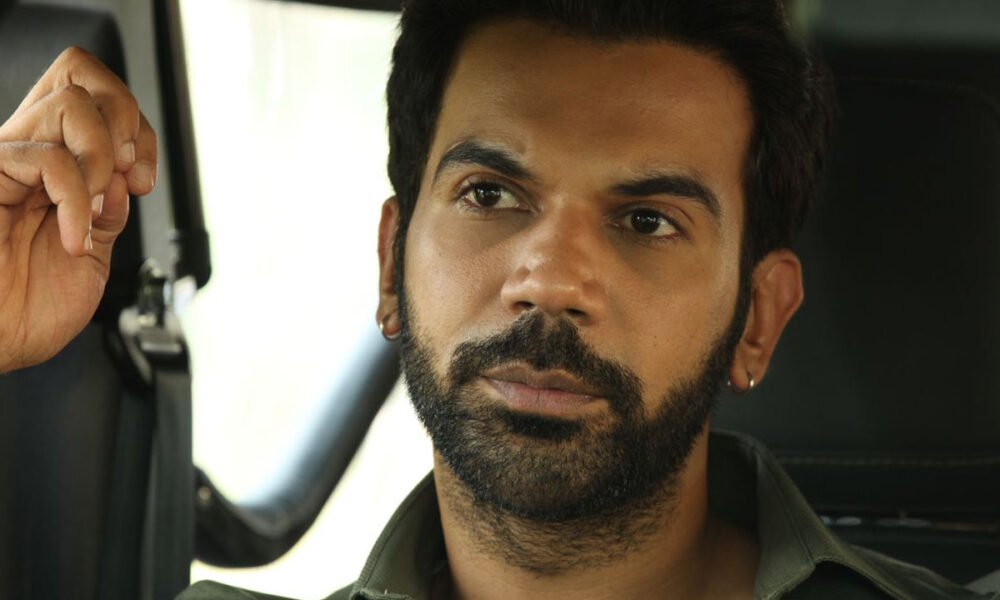Disclaimer: HIT-The First Case review is not spoiler free.
Vikram, played by Rajkumar Rao, is a police officer with post-traumatic stress disorder. The severity of his condition is so high that he might suffer from a stroke if he continues to work in the homicide intervention team. Needless to say, our protagonist is a sharp police officer who is favored by his seniors for his brilliant work record. His work exposes him to several triggers at a very high frequency, rendering him vulnerable to the simplest of situations that a homicide detective can be expected to witness on the job. Upon insistence by his partner, Neha, an officer in the forensic department, played by Sanya Malhotra, and his doctor, he agrees to take a long leave from work and focus on healing. The term is merely an escape, not from the past but the triggers of the present. However, the period of leave is cut short as Neha goes missing. To summarize, HIT is about a police officer suffering from PTSD working on a missing person’s case.
The foundation for investigation is set. The anatomy of a suspense thriller is always tough to crack because continued attention is secured via characters, while suspense is created through the atmosphere and characters’ mobility within it. Such a narrative necessitates a screenplay built with two foci. Rajkumar Rao is required to be active in his role of investigator and reactive as a mental health patient. The switch is smooth due to Rao’s ability to perform. He plays a no-nonsense character who is not exactly emotionally unavailable. He internalizes the meticulousness and mental rigidity the character requires. At the same time, he manages to express his vulnerability in his body language. Mentioning Rao becomes important as he is made to carry the film entirely, and so his performance becomes central to the experience. In the hands of an incapable actor, HIT-The First Case would have been tiresome to go through.
 One thing that bothers me about such films, in general, is how they treat the supporting characters in favor of the protagonist. To establish the sharp analytical skills of the protagonist, everyone else is reduced to a meek aide following orders with no agency, opinion, or wisdom of their own. So naturally, all investigations will be driven solely by the protagonist. Only he will come up with breakthroughs to further the investigation, while the job of others would be to follow instructions and invest trust in the protagonist’s process.
One thing that bothers me about such films, in general, is how they treat the supporting characters in favor of the protagonist. To establish the sharp analytical skills of the protagonist, everyone else is reduced to a meek aide following orders with no agency, opinion, or wisdom of their own. So naturally, all investigations will be driven solely by the protagonist. Only he will come up with breakthroughs to further the investigation, while the job of others would be to follow instructions and invest trust in the protagonist’s process.
Related to Hit the Case (2022) – 10 Best Hindi Films Of The Decade (2010s)
The subordination of characters to the protagonist is discomforting here as well, but it validates itself in the resolution leaving behind a better film. In both the pursuit of the past and present, HIT becomes a tightly knitted thriller inducing manageable anxiety. Not only does it induce anxiety from the lack of information about its plot, but it also incorporates multiple visual triggers that prohibit any character from rising beyond the circle of suspicion except for the ones in the lead. And that’s where the merit lies because it contributes to the unpredictability of the screenplay.
I’ve realized that Indian thrillers often tread on the very edge of smartness beyond which lies pretension. A single miscalculated step and the film implodes. Self-indulgence is not harmful as long as it comes from a place of self-confidence. But unfortunately, self-indulgence in Indian thrillers stems partially from the inferiority complex of not being as remarkable as the South Korean or American counterparts and partially from the need to do something that has never been done before. And surprisingly, the need to do something never been done before is never exercised in sketching a sociopolitical or moral crisis but in making the plot bizarre enough to be statistically anomalous.
The more bizarre the case, the better it is considered in a theoretical sense. Unfortunately, the theorized merits never get translated optimally. A film that pretends to move within familiar peripheries starts taking unpredictable turns until finally falling in the third act after getting entwined in the indiscernible web of its design. The merit of its first two acts aside, HIT is no different.
The film gets obsessed with what it creates that it forgets what it might lead to. Therefore, we are served with a resolution that is strange. But the reality is not strange either, so why not accept this with a full heart? The answer to the question would be the implications HIT-The First Case’s resolution carries. HIT engages in queerbaiting to establish a believable cause for the conflict in the film. Having queer characters isn’t wrong. Nor is their identity. The film doesn’t endorse that either. Hence, it cannot be rejected with a simple note of being problematic in this regard. After all, expecting a sanitized construction of screenplay if it involves a queer character or rejecting queer representation altogether if it is not sanitized is too big a burden to put on a film. Because importantly, the writing of the resolution is without any ill intention.
Also, Read – Rajkumar Rao And Ayushmann Khurrana: Redefining The Definition Of A Hindi Film Hero
It is loud enough to point out the cause of an event than the event itself. And the cause is rooted in societal stigma around queerness and mental health. In simpler terms, HIT’s resolution is based on the idea that if we continue to be rigidly orthodox and phobic of marginalized identities, then the marginalization will induce a reactive assault in many forms. It is a negative argument per se to make in favor of the marginalized, for it doesn’t focus on the harmony potential of social acceptance but on the violence potential of social rejection.
We must do this not because it is the right thing to do but because doing otherwise will only lead to terrible things affecting all groups alike. It is only without any ill intention and not so much well-intentioned in itself. But I am not saying this is exactly what the resolution is a metaphor for. It is merely an implication, the impact of which cannot be ascertained.
I definitely recommend HIT-The First Case as an experience if the genre is close to your heart. Or if Rajkumar Rao is who you wait for. The film is more rewarding than underwhelming, and we must embrace it.



![Honeyland [2019]: ‘Sundance’ Review – An Exceptional and Unembellished Tale of a Woman’s Connection with Nature](https://79468c92.delivery.rocketcdn.me/wp-content/uploads/2019/06/Honeyland-high-on-films-768x513.jpg)
![50 Years Later: Flesh [1968]](https://79468c92.delivery.rocketcdn.me/wp-content/uploads/2018/09/vlcsnap-error218.jpg)
![Heaven knows What [2015]: ‘Mad Love in New York City’](https://79468c92.delivery.rocketcdn.me/wp-content/uploads/2016/08/heaven-knows-what-4-768x432.jpg)


